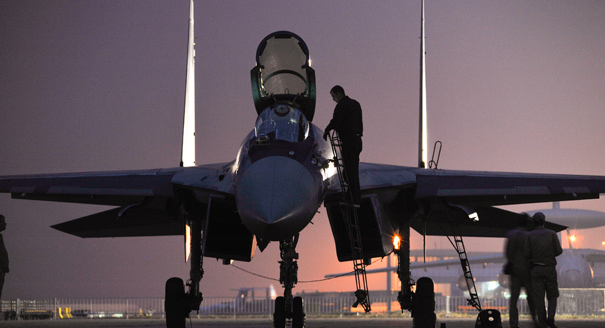Russia recently sent several Su-35 fighter jets to the Khmeimim air base in Syria, marking the first time that the aircraft have been deployed to a combat zone. In the coming years, the Su-35 will not only be critical to Russian aerial campaigns in the Middle East, but may also affect the balance of power in East Asia: Russia is set to deliver 24 Su-35s to China over the next two years.
Last fall, in the second major Russo-Chinese arms deal since the beginning of the Ukraine crisis, Russia agreed to sell two dozen Su-35s to China for $2 billion. In 2014, Russia and China signed a contract for S-400 surface-to-air missile systems that was estimated to be worth at least $1.9 billion. However, neither deal should be seen as a consequence of the Ukraine crisis: negotiations on both deals began before the EuroMaidan Revolution, and most points of contention were resolved by 2014.
Before the Su-35 contract was signed, Russian arms export to China had been barely growing, staying in the range of $1.5 billion to $2 billion per year. The arms trade between the two countries can soon be expected to return to the “golden age” of the late 1990s and early 2000s, when it reached $2.7 billion per year.
The Russian Rationale
The contract has already been a political success for Moscow, highlighting Beijing’s reliance on Russian defense equipment despite its frequent claims of military independence.
The deal has also been an economic success for Russia, in part because of the continued devaluation of the ruble. Since the ruble lost half of its value in late 2014, it has become much more profitable to export weapons, which are manufactured almost exclusively with Russian parts and materials. The deal may substantially improve the financial standing of the United Aircraft Corporation and the Komsomolsk-on-Amur Aircraft Production Association (KNAAPO), the largest and most important manufacturer of aircraft in Russia.
The sale may also lead to contracts for systems and components to be used in new Chinese fighter jets, as well as agreements on technology transfers or research and development. Lastly, the sale improves the prospects for sales of Su-35s to other countries. Indonesia is expected to be the next state to order the jet.
Chinese Interests
Beijing’s rationale for buying Su-35s is less straightforward. China has demonstrated that it can independently design and produce 4++ generation fighter jets, and is now working on two fifth-generation aircraft, the J-20 and the J-31. As China’s domestic production capabilities have increased, nationalist elements of the Chinese government have grown louder in their opposition to the purchase of foreign military equipment. What’s more, the sale of the Su-35s will not significantly boost the combat capability of the Chinese air force, as 24 jets will only be enough for one regiment.
Some have suggested that the Chinese bought the jets in order to reverse engineer them, but this is highly unlikely. The Su-35’s engines and avionics, including its powerful Irbis radar system, cannot be reverse engineered in any reasonable amount of time.
The purchase is part of a larger Chinese push to develop its air force. Of the two Chinese aircraft being developed—the J-20 and the J-31—only the J-20 can be considered a true fifth-generation fighter. The J-31 uses stealth technology, but its main systems and components are borrowed from 4+ generation aircraft, including the J-10B, J-16, and FC-1. As for the J-20—the pinnacle of Chinese aviation engineering—it is unclear if and when it will be ready for combat, if the experience of the United States and other countries working on fifth-generation jets is any guide.
Over the next ten to fifteen years, fighter jets based on the Su-27, such as the J-11B, J-11BS, J-15, and J-16, will constitute the core of Chinese air power. China is already working on upgrading them. It is currently testing the revamped J-11D, which is equipped with an active phased array radar and other enhancements. The Su-35, Russia’s most advanced variant of the Su-27, will allow the Chinese air force to gauge its success in developing the J-11, become familiar with Russian solutions to technical problems, and plot a course for further action.
Though the sale is relatively small, it may have a considerable impact on regional security: even a single regiment of Su-35s may be enough to affect the balance of power in Taiwan. Irbis radar systems can detect airborne targets at a range of up to 400 kilometers, which will allow Beijing to monitor Taiwanese airspace from Mainland China.
Vassily Kashin is a senior fellow at the Institute of Far Eastern Studies of the Russian Academy of Sciences.
